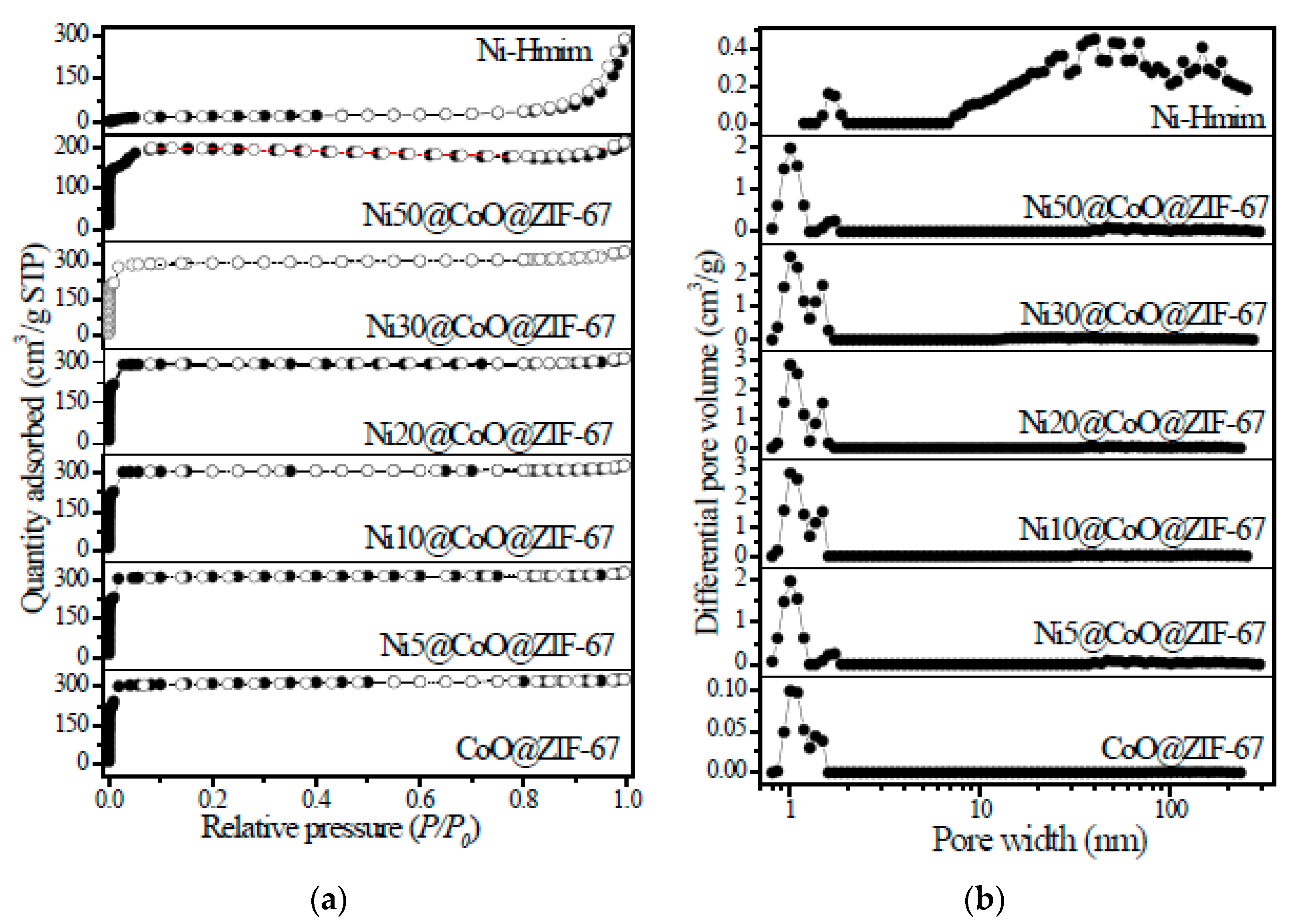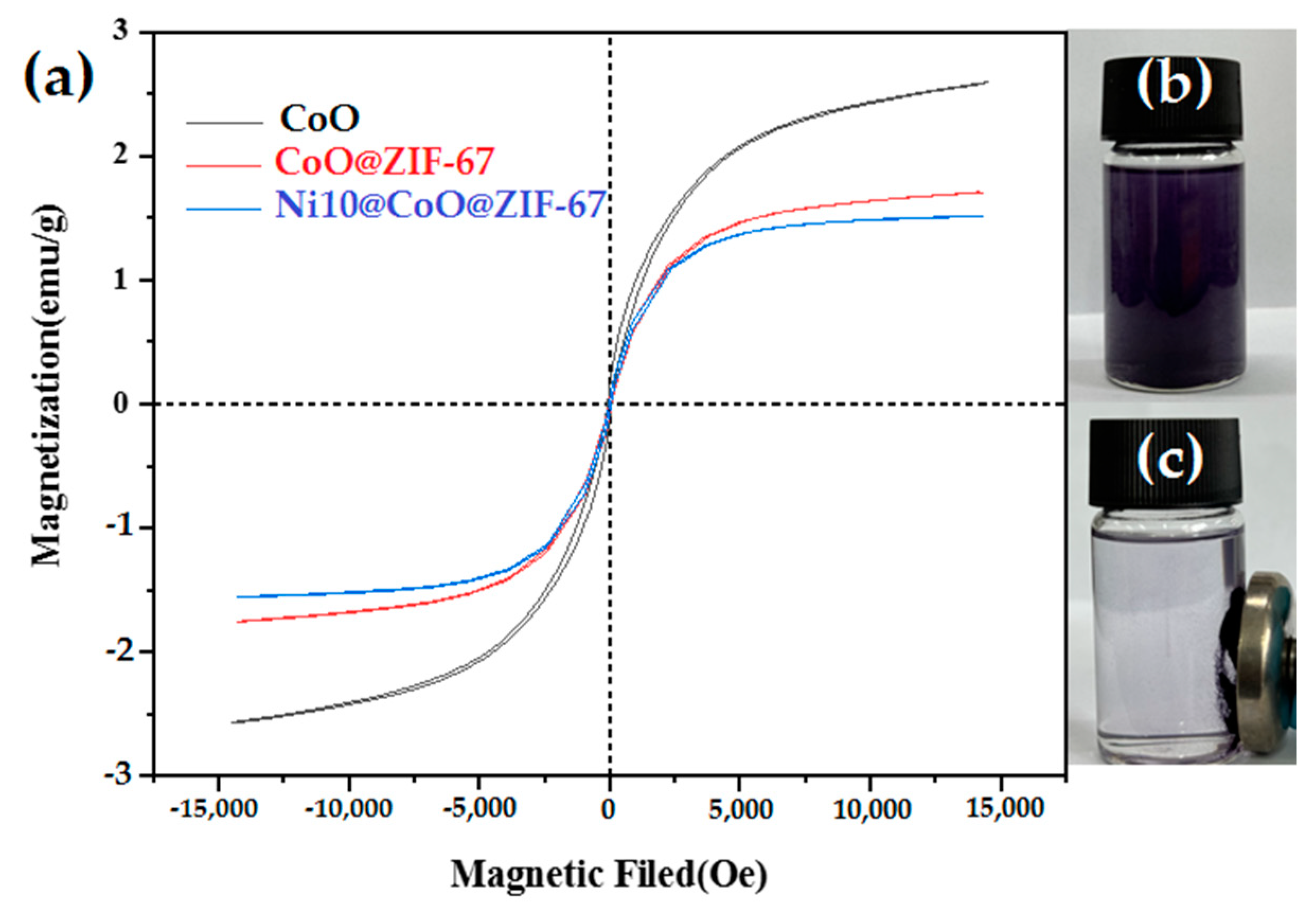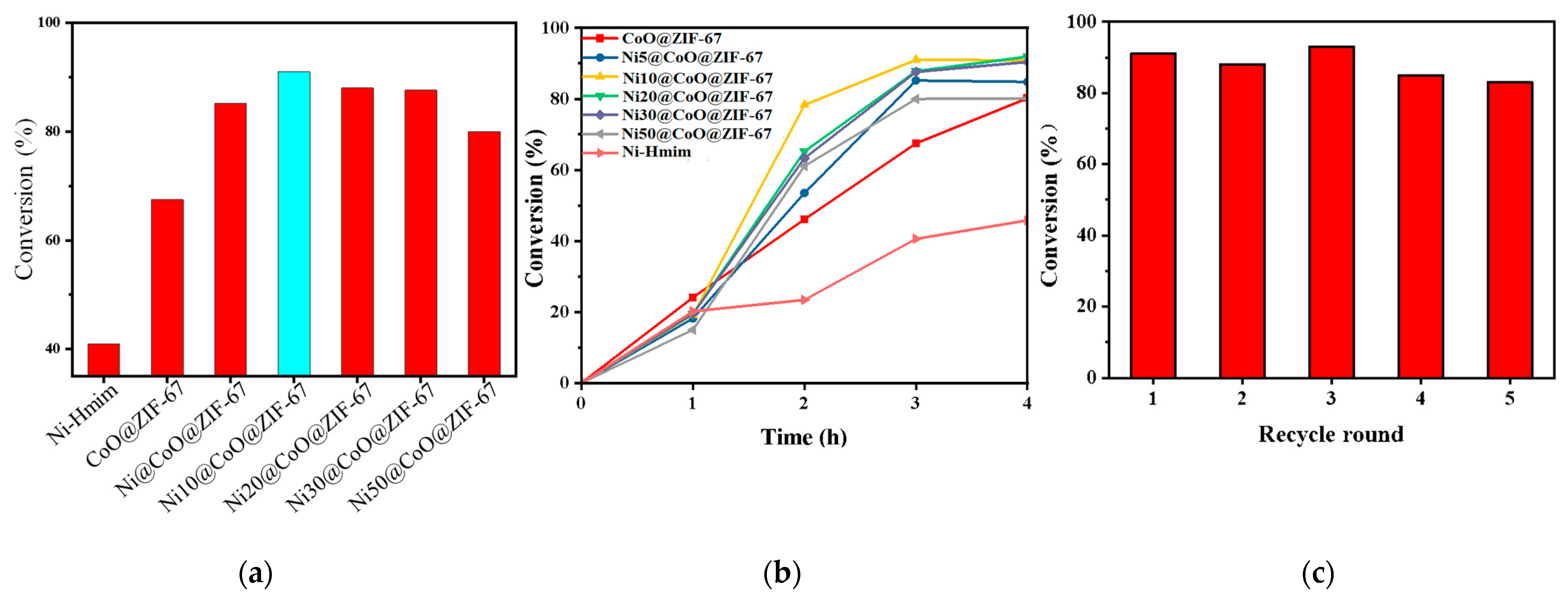The Facile Synthesis of Nickel-Doped Composite Magnetic Ni@CoO@ZIF-67 as an Efficient Heterogeneous Catalyst for the Ring-Opening Polymerization of L-Lactide
Abstract
:1. Introduction
2. Results and Discussion
2.1. Material Synthesis and Characterization
2.2. Ring-Opening Polymerization of L-Lactide
3. Materials and Methods
3.1. Chemicals and Catalyst Synthesis
3.2. Characterization
3.3. ROP for Synthesis PLA
4. Conclusions
Supplementary Materials
Author Contributions
Funding
Data Availability Statement
Conflicts of Interest
References
- Ali, A.; Bahadar, A.; Khan, A.; Sanaullah, K. Role of agricultural waste in recycled plastic biocomposites. In Recycled Plastic Biocomposites; Elsevier: Amsterdam, The Netherlands, 2022; pp. 165–194. [Google Scholar]
- Taib, N.-A.A.B.; Rahman, M.R.; Huda, D.; Kuok, K.K.; Hamdan, S.; Bakri, M.K.B.; Julaihi, M.R.M.B.; Khan, A. A review on poly lactic acid (PLA) as a biodegradable polymer. Polym. Bull. 2023, 80, 1179–1213. [Google Scholar] [CrossRef]
- Farah, S.; Anderson, D.G.; Langer, R. Physical and mechanical properties of PLA, and their functions in widespread applications—A comprehensive review. Adv. Drug Delivery Rev. 2016, 107, 367–392. [Google Scholar] [CrossRef] [PubMed]
- McKeown, P.; Jones, M.D. The chemical recycling of PLA: A review. Sustain. Chem. 2020, 1, 1–22. [Google Scholar] [CrossRef]
- Torres, A.; Li, S.; Roussos, S. Poly(lactic acid) degradation in soil or under controlled conditions. J. Appl. Polym. Sci. 1996, 62, 2295–2302. [Google Scholar] [CrossRef]
- Li, S.; Girard, A.; Garreau, H.; Vert, M. Enzymatic degradation of polylactide stereocopolymers with predominant D-lactyl contents. Polym. Degrad. Stab. 2000, 71, 61–67. [Google Scholar] [CrossRef]
- Bubpachat, T.; Sombatsompop, N.; Prapagdee, B. Isolation and role of polylactic acid-degrading bacteria on degrading enzymes productions and PLA biodegradability at mesophilic conditions. Polym. Degrad. Stab. 2018, 152, 75–85. [Google Scholar] [CrossRef]
- Nampoothiri, K.M.; Nair, N.R.; John, R.P. An overview of the recent developments in polylactide (PLA) research. Bioresour. Technol. 2010, 101, 8493–8501. [Google Scholar] [CrossRef]
- Masutani, K.; Kimura, Y. PLA synthesis. From the monomer to the polymer. In Poly(lactic acid) Science and Technology: Processing, Properties, Additives and Applications; The Royal Society of Chemistry: London, UK, 2014. [Google Scholar]
- Lee, E.J.; Lee, K.M.; Jang, J.; Kim, E.; Chung, J.S.; Do, Y.; Yoon, S.C.; Park, S.Y. Characteristics of silica-supported tin(II) methoxide catalysts for ring-opening polymerization (ROP) of L-lactide. J. Mol. Catal. A Chem. 2014, 385, 68–72. [Google Scholar] [CrossRef]
- Kang, M.-S.; Cho, J.; Nayab, S.; Jeong, J.H. Synthesis and characterization of Zn(II) and Cu(II) complexes bearing (chiral substituent)(diethyl)-ethanediamine derivatives as precatalysts for rac-lactide polymerisation. Polyhedron 2019, 158, 135–143. [Google Scholar] [CrossRef]
- Punyodom, W.; Meepowpan, P.; Girdthep, S.; Limwanich, W. Influence of tin (II), aluminum (III) and titanium (IV) catalysts on the transesterification of poly (L-lactic acid). Polym. Bull. 2022, 79, 11409–11429. [Google Scholar] [CrossRef]
- McGuire, T.M.; Buchard, A.; Williams, C. Chemical Recycling of Commercial Poly (l-lactic acid) to l-Lactide Using a High-Performance Sn (II)/Alcohol Catalyst System. J. Am. Chem. Soc. 2023, 145, 19840–19848. [Google Scholar] [CrossRef] [PubMed]
- Gao, C.; Wang, Y.; Yang, Y.; Qin, S. Poly (lactic acid) synthesized from non-food biomass feedstocks with tin-loaded ZA molecular sieve catalysts by direct melt polycondensation. Polym. Int. 2024, 73, 310–318. [Google Scholar] [CrossRef]
- Wanna, N.; Kraithong, T.; Khamnaen, T.; Phiriyawirut, P.; Charoenchaidet, S.; Tantirungrotechai, J. Aluminum-and calcium-incorporated MCM-41-type silica as supports for the immobilization of titanium (IV) isopropoxide in ring-opening polymerization of l-lactide and ε-caprolactone. Catal. Commun. 2014, 45, 118–123. [Google Scholar] [CrossRef]
- Jones, M.D.; Davidson, M.G.; Keir, C.G.; Hughes, L.M.; Mahon, M.F.; Apperley, D.C. Zinc (II) Homogeneous and Heterogeneous Species and Their Application for the Ring-Opening Polymerisation of rac-Lactide; Wiley Online Library: Hoboken, NJ, USA, 2009. [Google Scholar]
- Luo, Z.; Chaemchuen, S.; Zhou, K.; Verpoort, F. Ring-Opening Polymerization of l-Lactide to Cyclic Poly (Lactide) by Zeolitic Imidazole Framework ZIF-8 Catalyst. ChemSusChem 2017, 10, 4135–4139. [Google Scholar] [CrossRef] [PubMed]
- Chaemchuen, S.; Dai, Q.; Wang, J.; Zhu, C.; Klomkliang, N.; Yuan, Y.; Cheng, C.; Elkadi, M.; Luo, Z.; Verpoort, F. Enhancing catalytic activity via metal tuning of zeolitic imidazole frameworks for ring opening polymerization of l-lactide. Appl. Catal. A 2021, 624, 118319. [Google Scholar] [CrossRef]
- Naz, F.; Mousavi, B.; Luo, Z.; Jabbour, C.; Heynderickx, P.M.; Chaemchuen, S.; Verpoort, F. Switching from linear to cyclic δ-Polyvalerolactone synthesized via zeolitic imidazolate framework as a catalyst: A promising approach. Appl. Organomet. Chem. 2019, 33, e4890. [Google Scholar] [CrossRef]
- Abdur, R.M.; Mousavi, B.; Shahadat, H.M.; Akther, N.; Luo, Z.; Zhuiykov, S.; Verpoort, F. Ring-opening copolymerization of ε-caprolactone and δ-valerolactone by a titanium-based metal–organic framework. New J. Chem. 2021, 45, 11313–11316. [Google Scholar] [CrossRef]
- Luo, Z.; Chaemchuen, S.; Zhou, K.; Gonzalez, A.A.; Verpoort, F. Influence of lactic acid on the catalytic performance of MDABCO for ring-opening polymerization of L-lactide. Appl. Catal. A 2017, 546, 15–21. [Google Scholar] [CrossRef]
- Chaemchuen, S.; Luo, Z.; Zhou, K.; Mousavi, B.; Phatanasri, S.; Jaroniec, M.; Verpoort, F. Defect formation in metal–organic frameworks initiated by the crystal growth-rate and effect on catalytic performance. J. Catal. 2017, 354, 84–91. [Google Scholar] [CrossRef]
- Liu, Y.; Ren, Z.; Zhang, N.; Yang, X.; Wu, Q.; Cheng, Z.; Xing, H.; Bai, Y. A nanoscale MOF-based heterogeneous catalytic system for the polymerization of N-carboxyanhydrides enables direct routes toward both polypeptides and related hybrid materials. Nat. Commun. 2023, 14, 5598. [Google Scholar] [CrossRef]
- Chaemchuen, S.; Wu, Q.; Gu, J.-F.; Yuan, Y.; Klomkliang, N.; Verpoort, F. Solvent-Free Synthesis of Composite Magnetic CoO@ ZIF-67 for Efficient and Practical Use. Microporous Mesoporous Mater. 2024, 376, 113200. [Google Scholar] [CrossRef]
- Zhao, J.; Guo, G.; Wang, D.; Liu, H.; Zhang, Z.; Sun, L.; Ding, N.; Li, Z.; Zhao, Y. A “one-step” approach to the highly efficient synthesis of lactide through the confinement catalysis of covalent organic frameworks. Green Chem. 2023, 25, 3103–3110. [Google Scholar] [CrossRef]
- Debruyne, M.; Van Speybroeck, V.; Van Der Voort, P.; Stevens, C.V. Porous organic polymers as metal free heterogeneous organocatalysts. Green Chem. 2021, 23, 7361–7434. [Google Scholar] [CrossRef]
- Chaemchuen, S.; Zhou, K.; Mousavi, B.; Ghadamyari, M.; Heynderickx, P.M.; Zhuiykov, S.; Yusubov, M.S.; Verpoort, F. Spray drying of zeolitic imidazolate frameworks: Investigation of crystal formation and properties. CrystEngComm 2018, 20, 3601–3608. [Google Scholar] [CrossRef]
- Sun, Y.; Zhang, N.; Yue, Y.; Xiao, J.; Huang, X.; Ishag, A. Recent advances in the application of zeolitic imidazolate frameworks (ZIFs) in environmental remediation: A review. Environ. Sci. Nano 2022, 9, 4069–4092. [Google Scholar] [CrossRef]
- Wang, J.; Chaemchuen, S.; Klomkliang, N.; Verpoort, F. In situ thermal solvent-free synthesis of zeolitic imidazolate frameworks with high crystallinity and porosity for effective adsorption and catalytic applications. Cryst. Growth Des. 2021, 21, 5349–5359. [Google Scholar] [CrossRef]
- Shi, G.; Xu, W.; Wang, J.; Klomkliang, N.; Mousavi, B.; Chaemchuen, S. Thermochemical transformation in the single-step synthesis of zeolitic imidazole frameworks under solvent-free conditions. Dalton Trans. 2020, 49, 2811–2818. [Google Scholar] [CrossRef] [PubMed]
- Dutta, S.; Hung, W.-C.; Huang, B.-H.; Lin, C.-C. Recent developments in metal-catalyzed ring-opening polymerization of lactides and glycolides: Preparation of polylactides, polyglycolide, and poly (lactide-co-glycolide). Synth. Biodegrad. Polym. 2011, 245, 219–283. [Google Scholar]
- John, A.; Katiyar, V.; Pang, K.; Shaikh, M.M.; Nanavati, H.; Ghosh, P. Ni (II) and Cu (II) complexes of phenoxy-ketimine ligands: Synthesis, structures and their utility in bulk ring-opening polymerization (ROP) of L-lactide. Polyhedron 2007, 26, 4033–4044. [Google Scholar] [CrossRef]
- Sun, J.; Shi, W.; Chen, D.; Liang, C. The ring-opening polymerization of D,L-lactide catalyzed by new complexes of Cu, Zn, Co, and Ni Schiff base derived from salicylidene and L-aspartic acid. J. Appl. Polym. Sci. 2002, 86, 3312–3315. [Google Scholar] [CrossRef]
- Banerjee, R.; Phan, A.; Wang, B.; Knobler, C.; Furukawa, H.; O’Keeffe, M.; Yaghi, O.M. High-throughput synthesis of zeolitic imidazolate frameworks and application to CO2 capture. Science 2008, 319, 939–943. [Google Scholar] [CrossRef]
- Wu, Q.; Gu, J.; Wang, J.; Liu, N.; Chaemchuen, S. Impact in rational synthesis Co-ZIF templates for derived the structural Co@ NC catalysis for high efficient hydrogen and oxygen evolution reactions. Int. J. Hydrogen Energy 2023, 48, 2663–2676. [Google Scholar] [CrossRef]
- Shi, S.; Liu, Z.; Miao, X.; Wang, C.; Liu, B.; Wang, G.; Jin, Z. Broad-spectrum absorptive ZnCr LDHs/ZIF-67 S-scheme heterojunction for hydrogen evolution reaction under visible irradiation. J. Photochem. Photobiol. A 2024, 455, 115768. [Google Scholar] [CrossRef]
- Thamilselvan, A.; Dang, V.D.; Doong, R.-A. Ni-Co bimetallic decorated dodecahedral ZIF as an efficient catalyst for photoelectrochemical degradation of sulfamethoxazole coupled with hydrogen production. Sci. Total Environ. 2023, 873, 162208. [Google Scholar] [CrossRef]
- Cheng, C.; Zhang, J.; Zeng, R.; Xing, F.; Huang, C. Schottky barrier tuning via surface plasmon and vacancies for enhanced photocatalytic H2 evolution in seawater. Appl. Catal. B 2022, 310, 121321. [Google Scholar] [CrossRef]
- Xie, H.; Wang, K.; Li, S.; Jin, Z. Construction of Co9S8/MoS2/Ni2P double S-scheme heterojunction for enhanced photocatalytic hydrogen evolution. Surf. Interfaces 2023, 42, 103353. [Google Scholar] [CrossRef]
- Yue, X.; Dong, Y.; Cao, H.; Wei, X.; Zheng, Q.; Sun, W.; Lin, D. Effect of electronic structure modulation and layer spacing change of NiAl layered double hydroxide nanoflowers caused by cobalt doping on supercapacitor performance. J. Colloid Interface Sci. 2023, 630, 973–983. [Google Scholar] [CrossRef]







| Material | Surface Area (m2/g) | Pore Volume 1 (cm3/g) | Pore Size 1 (nm) | |
|---|---|---|---|---|
| BET | Langmuir | |||
| CoO@ZIF-67 | 1353 | 1432 | 0.48 | 1.25 |
| Ni5@CoO@ZIF-67 | 1351 | 1437 | 0.48 | 1.25 |
| Ni10@CoO@ZIF-67 | 1367 | 1440 | 0.47 | 1.25 |
| Ni20@CoO@ZIF-67 | 1312 | 1399 | 0.45 | 1.25 |
| Ni30@CoO@ZIF-67 | 1290 | 1371 | 0.46 | 1.25 |
| Ni50@CoO@ZIF-67 | 753 | 797 | 0.30 | 1.23 |
| Ni-Hmim | 107 | 124 | 0.03 | 2.17 |
Disclaimer/Publisher’s Note: The statements, opinions and data contained in all publications are solely those of the individual author(s) and contributor(s) and not of MDPI and/or the editor(s). MDPI and/or the editor(s) disclaim responsibility for any injury to people or property resulting from any ideas, methods, instructions or products referred to in the content. |
© 2024 by the authors. Licensee MDPI, Basel, Switzerland. This article is an open access article distributed under the terms and conditions of the Creative Commons Attribution (CC BY) license (https://creativecommons.org/licenses/by/4.0/).
Share and Cite
Chen, X.; Wu, Q.; Chaemchuen, S.; Verpoort, F. The Facile Synthesis of Nickel-Doped Composite Magnetic Ni@CoO@ZIF-67 as an Efficient Heterogeneous Catalyst for the Ring-Opening Polymerization of L-Lactide. Catalysts 2024, 14, 490. https://doi.org/10.3390/catal14080490
Chen X, Wu Q, Chaemchuen S, Verpoort F. The Facile Synthesis of Nickel-Doped Composite Magnetic Ni@CoO@ZIF-67 as an Efficient Heterogeneous Catalyst for the Ring-Opening Polymerization of L-Lactide. Catalysts. 2024; 14(8):490. https://doi.org/10.3390/catal14080490
Chicago/Turabian StyleChen, Xingxing, Qing Wu, Somboon Chaemchuen, and Francis Verpoort. 2024. "The Facile Synthesis of Nickel-Doped Composite Magnetic Ni@CoO@ZIF-67 as an Efficient Heterogeneous Catalyst for the Ring-Opening Polymerization of L-Lactide" Catalysts 14, no. 8: 490. https://doi.org/10.3390/catal14080490








